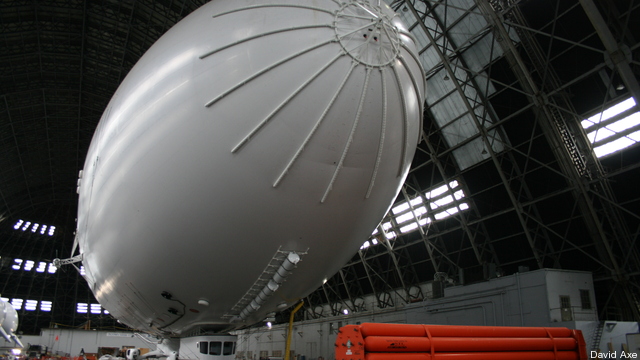Blue Devil Airship Maker Sends SOS After Air Force Says Pack It Up
Posted on

WASHINGTON: This is a deflating month – literally — for Mav6, a small Mississippi defense company that’s been working five years to complete a massive military airship, the unmanned M1400 Blue Devil II intelligence, surveillance and reconnaissance (ISR) craft.
On orders from the Air Force, “We’ve started to disassemble the airship,” reports David Deptula, CEO of Mav6, who retired from the Air Force in October 2010 as a three-star general and deputy chief of staff for ISR. Mav6 and its supporters in Congress are hoping the Navy will save Blue Devil II from what they view as a short-sighted decision by the Air Force, which two years ago took over the project from the Army.
At 370 feet in length – longer than a football field — and 1.4 million cubic feet in volume, the M1400 isn’t just the largest airship built in half a century but also the largest unmanned aerial system ever. Inflated with helium last September and tethered inside a hangar 1,000 feet long in Elizabeth City, N.C., Blue Devil II last year won a “Best of What’s New” award from Popular Science magazine, which called it a “floating military supercomputer.”
Designed to carry as many as 10 modular sensor payloads weighing up to a combined 6,500 lbs. and to hover with them at 20,000 feet for five days — far longer than airplane unmanned aerial systems like the MQ-1 Predator and MQ-9 Reaper — Blue Devil II was begun in 2010 by the Army Engineering and Research Development Command as an “urgent operational need” for the war in Afghanistan. Among the sensors the airship is designed to carry are a wide-area airborne surveillance system with daylight and infrared cameras that can be cued by a signals intelligence intercept sensor. The airship also is to carry computers on board to process the imagery from its cameras and multiple datalinks to stream it to analysts in a timely fashion. Tracking down insurgents planting improvised explosive devices was going to be Blue Devil II’s primary mission in Afghanistan.
A Mav6 fact sheet contends that the Air Force, which “has openly stated they have no requirement for an airship,” began trying to kill the program from the time it took it over from the Army in the fall of 2011, delaying payments to the contractor and adding requirements. The Air Force has certainly subjected Blue Devil II to a slow death, first ordering Mav6 last January to stop doing the work required to fit the sensors and computers onto the airship, then, on May 23, telling the company to “deflate and crate” the aircraft.
“The decision to halt payload integration was based on several factors to include schedule delays, technical challenges, and higher than expected deployment costs,” an Air Force statement on the project says. “Since that time, technical problems have remained to include flight control software, tailfin design and electrical system wiring.” The Air Force has estimated that the potential cost of sending the airship to Afghanistan has doubled.
The Mav6 fact sheet concedes that when the Air Force told the company to “deflate and crate” in May, the project was 12 percent over budget and eight months behind schedule. The fact sheet, however, argues that for another $3 million the airship could still make a first flight no later than Aug. 31, while draining the $350,000 worth of helium inside the dirigible and storing the equipment will cost $2.6 million. After spending $143 million on the airship and sensor payloads for it already, the government would be wiser to “allow a demonstration of the capabilities and viability of today’s airship technology,” argues Mav6.
Mav6 hopes the Navy might come to Blue Devil II’s rescue because of that service’s history of using airships. The Naval Air Warfare Center Aircraft Division’s Airship Systems Engineering Team did a favorable study of Blue Devil II in May that’s been working its way up the Navy Department chain of command, and the fiscal 2012 defense budget still contains $55 million for the project that hasn’t been spent.
“The Defense Department would be wise to capitalize on the investment they’ve made in this potentially game-changing capability,” said Deptula, who is also a member of the Breaking Defense Board of Contributors. “It provides the kind of persistence, modularity and cost effectiveness that’s needed in the fiscally constrained future the Department of Defense is facing.”
Blue Devil II doesn’t have to sit over Afghanistan to provide valuable ISR, Mav6 argues. Stationed over a friendly nation such as Oman or the United Arab Emirates, for example, its daylight and infrared wide area airborne surveillance cameras and signals intelligence sensors could monitor the strategic Straits of Hormuz, the entrance to the Persian Gulf, and “see” as much as 200 miles into Iran.
Even though it’s as large as it is, the airship would be nearly impossible for an enemy to shoot down, for the pressure differential on either side of its hull is minimal, meaning shells as large as 20mm would just pass through, Deptula said. It also has six engines, so taking out one won’t bring it down. “You’d need about a 20-foot gash in this thing to make a difference, and even then it would settle gracefully,” he said.
The Air Force, though, doesn’t seem to have any problem shooting Blue Devil II down. The service’s statement doesn’t offer even a hint of support for the idea of letting the Navy take over, nor for using Blue Devil II for purposes other than the original plan to track IED planters in Afghanistan. “As the contract period of performance ends 30 June 2012,” the Air Force said flatly, “the remaining time and funds will be used to disassemble, pack, and ship the residual equipment and hardware.”
Subscribe to our newsletter
Promotions, new products and sales. Directly to your inbox.
